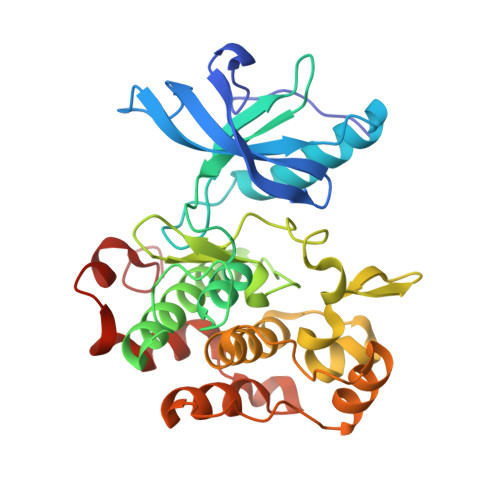A highly selective dual insulin receptor (IR)/insulin-like growth factor 1 receptor (IGF-1R) inhibitor derived from an extracellular signal-regulated kinase (ERK) inhibitor.
Anastassiadis, T., Duong-Ly, K.C., Deacon, S.W., Lafontant, A., Ma, H., Devarajan, K., Dunbrack, R.L., Wu, J., Peterson, J.R.(2013) J Biol Chem 288: 28068-28077
- PubMed: 23935097
- DOI: https://doi.org/10.1074/jbc.M113.505032
- Primary Citation of Related Structures:
4IBM - PubMed Abstract:
Dual inhibitors of the closely related receptor tyrosine kinases insulin-like growth factor 1 receptor (IGF-1R) and insulin receptor (IR) are promising therapeutic agents in cancer. Here, we report an unusually selective class of dual inhibitors of IGF-1R and IR identified in a parallel screen of known kinase inhibitors against a panel of 300 human protein kinases. Biochemical and structural studies indicate that this class achieves its high selectivity by binding to the ATP-binding pocket of inactive, unphosphorylated IGF-1R/IR and stabilizing the activation loop in a native-like inactive conformation. One member of this compound family was originally reported as an inhibitor of the serine/threonine kinase ERK, a kinase that is distinct in the structure of its unphosphorylated/inactive form from IR/IGF-1R. Remarkably, this compound binds to the ATP-binding pocket of ERK in an entirely different conformation to that of IGF-1R/IR, explaining the potency against these two structurally distinct kinase families. These findings suggest a novel approach to polypharmacology in which two or more unrelated kinases are inhibited by a single compound that targets different conformations of each target kinase.
Organizational Affiliation:
From the Cancer Biology Program, Fox Chase Cancer Center, Philadelphia, Pennsylvania 19111.















